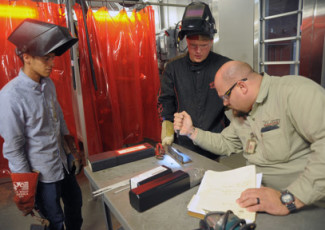Tailoring Programs to Employees Needs
By Sonya Stinson
February 23, 2016
In Idaho, colleges have a unique partnership with local employers. Here’s how they are providing more industry-qualified workers.
Within the past 15 years, the College of Southern Idaho (CSI) has seen 35 new and existing businesses drop more than $1 million in capital investments into the region, generating 5,000 jobs. For each employer considering an expansion in the region, CSI — which houses the Southern Idaho Economic Development Organization — has been at the forefront of the planning process.
CSI is part of a network of Idaho colleges working closely with employers to assess their workforce needs and to train people to meet those needs.
“We understand what types of positions they are going to be hiring for, what type of skill sets those individuals are going to need, and if there are any special certifications that are going to be needed,” says Brandi Turnipseed, director of workforce development at CSI. “The thing that is unique about this is that we become a partner with them from the very beginning, and we essentially are an extension of their HR and training department.”
 A customized approach
A customized approach
Along with programs providing industry-accepted credentials, in areas such as forklift operations, industrial maintenance and food safety, CSI also offers customized training for individual employers.
“Once the business is established and operating, often the management team determines, based on the skill level of the employees they hired, that they want to develop a training program that’s very specific to meet their needs,” Turnipseed says.
The college is currently working with Clif Bar & Co. to train some of its workers in high-tech food production. A recent spike in the demand for food-industry workers prompted CSI to start a new degree program in food technology, as part of the college’s agriculture department.
“With that, we don’t focus on one particular sector of food processing; we encompass everything from aquaculture to dairy to baking to potatoes,” Turnipseed says.
For all customized programs, CSI’s workforce trainers go on-site to learn about the employer’s equipment and production processes. Through its business partnerships, the college has received many donations of industrial equipment for its campus training center.
Turnipseed says the experience of creating a customized training program for one employer in an industry makes it easier to tailor training for other businesses filling similar jobs.
“What we have found is that there is definitely a baseline skill level that’s needed for a particular position,” she says. “Things that are consistent across those businesses, we incorporate into most or all of those training programs.”
 Staying flexible
Staying flexible
Ongoing curriculum development is another key aspect of CSI’s relationship with area employers.
“We are very diligent about trying to feed that pipeline, to make sure that we are filling that next-generation need,” Turnipseed says. “So we work with them to make sure that the curriculum we’re delivering meets their specific needs.”
Flexibility is an essential part of each training program’s design, especially for employers setting up a business in the area for the first time.
“Any startup is very challenging,” she says. “Hiring may or may not go as planned. Construction obviously may or may not go as planned. So building that flexibility in there has proven to be a real value.”
 The importance of agility
The importance of agility
Another big part of CSI’s workforce-training success is having the resources on hand and the physical and organizational infrastructure in place that allows it to respond in short order to new employer demands.
When Dell Computers was preparing to bring a call center to the Twin Falls area, back in 2001, CSI sent a representative down to the company’s headquarters in Plano, Texas, to assess its workforce needs.
“In a matter of two to three weeks, we had the entire training program built and launched,” Turnipseed says.
That kind of rapid response is possible because of the college’s active involvement in the region’s economic-development efforts. “We always have a pulse of what is coming up in the community, so we can plan, which is very important,” Turnipseed says.
Photos courtesy of College of Southern Idaho








